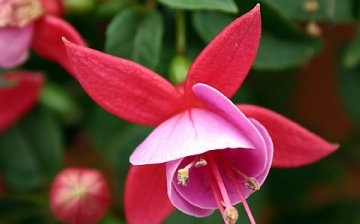Fuchsia - care and reproduction
So many ornamental garden and indoor plants have grown that it is sometimes difficult to opt for one thing. After all, if you do not have a spacious greenhouse or a sufficiently large plot of land, then you don't really have to roll out your lip. But still, not a single housewife will refuse to have several beautiful flowering plants at home. They refresh the room, bring a lively atmosphere and vibrant colors to it. Even in winter, summer stays in the house with flowers.
Fuchsia is the brainchild of an evergreen tropical shrub. In nature, it does not grow in our country, but fuchsia is found quite often in Russian houses as an ornamental plant. Maybe that's why our people fell in love with it, that it blooms profusely and for quite a long time, covering the entire bush with colorful inflorescences.
If you like fuchsia, caring for it is easy. This is a rather modest plant that does not require too much from its owner. She loves bright light, but it is better not direct sunlight, but scattered, even partial shade. In summer, it is better not to keep fuchsia in hot apartments - take it to the balcony, there it will be easier for the plant to breathe.
Naturally, if you take good care of the green pet (spray, feed), then it will look more lush, blooming, presentable.
After winter dormancy, fuchsia can be transplanted into new land. It is propagated most often by cuttings. When propagated by seeds, the offspring may differ from the mother bush.
The main pest enemies of fuchsia are the whitefly and spider mite. To combat them, there are various ready-made preparations and folk recipes.




How many times a year does this plant bloom and what needs to be done for this, how to fertilize? I really want to have a plant that would bloom beautifully and regularly in my house. Judging by the fact that the flower is tropical, the room should also be warm.